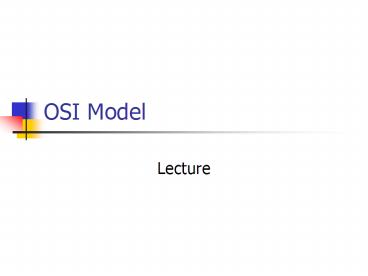OSI Model PowerPoint PPT Presentation
1 / 17
Title: OSI Model
1
OSI Model
- Lecture
2
OSI Model
- OSI Open System Interconnect
- It is a reference model for how messages should
be transmitted between any two nodes in a
network. - Developed to guide implementers in standardizing
their products so that communications can occur
between different - Brands of equipment
- Protocols
- Media
- Operating Systems
- Simplifies the networking process for
teaching/learning
3
OSI Model 7 Layers
4
Remembering the OSI Model
- All 7 - Application
- People 6 - Presentation
- Seem 5 - Session
- To 4 - Transport
- Need 3 - Network
- Data 2 - Data Link
- Processing 1 - Physical
5
Physical Layer
Application
- Responsible for
- Voltage
- Frequency (timing of voltage changes)
- Data rates
- Transmission distances
- Physical topology
Presentation
Session
Transport
Network
Data Link
Physical
Protocol data unit bits or bitstream
6
Data Link Layer
Application
- Responsible for
- Physical addressing
Presentation
Session
Transport
Network
Data Link
Physical
Protocol data unit frames
7
Network Layer
Application
- Responsible for
- Network addressing (IP)
- Hierarchy
- 10.0.0.0 (network address)
- 10.0.1.0 (subnet)
- 10.0.2.0 (subnet)
- Best path determination
Presentation
Session
Transport
Network
Data Link
Physical
Protocol data unit packets
8
Transport Layer
Application
- Responsible for
- Reliable end-to-end data transport and delivery
of data - Sets up, maintains, and ends connections for the
network layer - Error detection and correction (dropped or
duplicate packets) - Guaranteed delivery
Presentation
Session
Transport
Network
Data Link
Physical
Protocol data unit segments
9
Session Layer
- Responsible for
- Monitoring and controlling synchronization of
data between applications (not apps like
wordprocessing, spreadsheets) but FTP, Telnet,
and SMTP (e-mail) - Establishes, maintains and terminates sessions
between applications careful not to confuse
with Transport Layer - Error detection and notification to peer layer
Application
Presentation
Session
Transport
Network
Data Link
Physical
Protocol data unit data or datagrams
10
Presentation Layer
Application
- Responsible for
- Data formatting
- Converting from one format to another EBCDIC to
ASCII - Data encryption/decryption
- Securing data
- Data compression/decompression
- JPEG
- GIF
- WINZIP
Presentation
Session
Transport
Network
Data Link
Physical
Protocol data unit data or datagrams
11
Application Layer
Application
- Responsible for
- Processes that allow applications to use network
services. - Examples
- Open files on servers
- E-mail clients
- Web browsers
- Closest layer to the user.
Presentation
Session
Transport
Network
Data Link
Physical
Protocol data unit data or datagrams
12
PDU
- Protocol Data Unit
- The generic name for the structure of data
(messages) sent between peer layers of
communicating network devices.
13
Communication
Message to send to Workstation B
14
Encapsulation
Note The sending node (source) encapsulates the
data before sending it over the media and the
receiving node (destination) de-encapsulates the
message stripping off the headers and trailers
before it gets to the user.
Data
Network Header
Data
Frame Header
Network Header
Frame Trailer
Data
Frame Header
Frame Trailer
Network Header
15
Equipment
16
Protocol
- An agreed-upon format for transmitting data
between two devices.
17
Protocols Layer 4
- Connection-oriented
- TCP transmission control protocol
- Guarantees transport and delivery of packets
across networks - Error detection/correction
- Connectionless
- UDP user datagram protocol
- Best effort
- Fast

